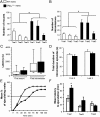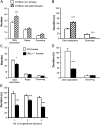Estrogen dependent activation function of ERβ is essential for the sexual behavior of mouse females
- PMID: 23150547
- PMCID: PMC3511745
- DOI: 10.1073/pnas.1217668109
Estrogen dependent activation function of ERβ is essential for the sexual behavior of mouse females
Abstract
We previously generated and characterized a genuine estrogen receptor (ER) β-null mouse line (named ERβ(ST)(L-/L-)) and showed that ERβ(ST)(L-/L-) mice were sterile, due to an ovulation impairment in females and to an unknown reason in males, as their reproductive organs and spermatozoid motility appeared normal. We report here an assessment of the sexual behavior of ERβ(ST)(L-/L-) null mice. We found that ERβ(ST)(L-/L-) males display mildly impaired sexual behavior and that ERβ(ST)(L-/L-) females are significantly less receptive and less attractive than wild-type (WT) females. Decreased attractivity is also exhibited by ERβAF2(0) but not by ERβAF1(0) mutant females (females devoid of either AF2 or AF1 activation function of ERβ). Interestingly, by using an odor preference test, we have determined that the low attractiveness of ERβ(ST)(L-/L-) and ERβAF2(0) females is related to a deficiency of a volatile chemosignal.
Conflict of interest statement
The authors declare no conflict of interest.
Figures





Similar articles
-
Sterility and absence of histopathological defects in nonreproductive organs of a mouse ERbeta-null mutant.Proc Natl Acad Sci U S A. 2008 Feb 19;105(7):2433-8. doi: 10.1073/pnas.0712029105. Epub 2008 Feb 11. Proc Natl Acad Sci U S A. 2008. PMID: 18268329 Free PMC article.
-
A previously uncharacterized role for estrogen receptor beta: defeminization of male brain and behavior.Proc Natl Acad Sci U S A. 2005 Mar 22;102(12):4608-12. doi: 10.1073/pnas.0500752102. Epub 2005 Mar 10. Proc Natl Acad Sci U S A. 2005. PMID: 15761056 Free PMC article.
-
Double oestrogen receptor alpha and beta knockout mice reveal differences in neural oestrogen-mediated progestin receptor induction and female sexual behaviour.J Neuroendocrinol. 2003 Oct;15(10):978-83. doi: 10.1046/j.1365-2826.2003.01089.x. J Neuroendocrinol. 2003. PMID: 12969243
-
The role of Eralpha and ERbeta in the prostate: insights from genetic models and isoform-selective ligands.Ernst Schering Found Symp Proc. 2006;(1):131-47. doi: 10.1007/2789_2006_020. Ernst Schering Found Symp Proc. 2006. PMID: 17824175 Review.
-
New roles for estrogen receptor beta in behavior and neuroendocrinology.Front Neuroendocrinol. 2006 Jul;27(2):217-32. doi: 10.1016/j.yfrne.2006.02.004. Epub 2006 Apr 17. Front Neuroendocrinol. 2006. PMID: 16603234 Review.
Cited by
-
Zebrafish sexual behavior: role of sex steroid hormones and prostaglandins.Behav Brain Funct. 2015 Aug 13;11:23. doi: 10.1186/s12993-015-0068-6. Behav Brain Funct. 2015. PMID: 26385780 Free PMC article.
-
Reproductive function and behaviors: an update on the role of neural estrogen receptors alpha and beta.Front Endocrinol (Lausanne). 2024 Jun 24;15:1408677. doi: 10.3389/fendo.2024.1408677. eCollection 2024. Front Endocrinol (Lausanne). 2024. PMID: 38978624 Free PMC article. Review.
-
Estrogen Receptor β2 Oversees Germ Cell Maintenance and Gonadal Sex Differentiation in Medaka, Oryzias latipes.Stem Cell Reports. 2019 Aug 13;13(2):419-433. doi: 10.1016/j.stemcr.2019.07.013. Stem Cell Reports. 2019. PMID: 31412286 Free PMC article.
-
Partial hepatectomy induces delayed hepatocyte proliferation and normal liver regeneration in ovariectomized mice.Clin Exp Gastroenterol. 2015 Jul 2;8:175-82. doi: 10.2147/CEG.S80212. eCollection 2015. Clin Exp Gastroenterol. 2015. PMID: 26170710 Free PMC article.
-
A Dynamic Shift in Estrogen Receptor Expression During Granulosa Cell Differentiation in the Ovary.Endocrinology. 2025 Jan 6;166(2):bqaf006. doi: 10.1210/endocr/bqaf006. Endocrinology. 2025. PMID: 39834231
References
-
- Rissman EF, Wersinger SR, Taylor JA, Lubahn DB. Estrogen receptor function as revealed by knockout studies: Neuroendocrine and behavioral aspects. Horm Behav. 1997;31(3):232–243. - PubMed
-
- Wersinger SR, et al. Masculine sexual behavior is disrupted in male and female mice lacking a functional estrogen receptor alpha gene. Horm Behav. 1997;32(3):176–183. - PubMed
-
- Harris HA. Estrogen receptor-beta: Recent lessons from in vivo studies. Mol Endocrinol. 2007;21(1):1–13. - PubMed
Publication types
MeSH terms
Substances
LinkOut - more resources
Full Text Sources
Molecular Biology Databases

